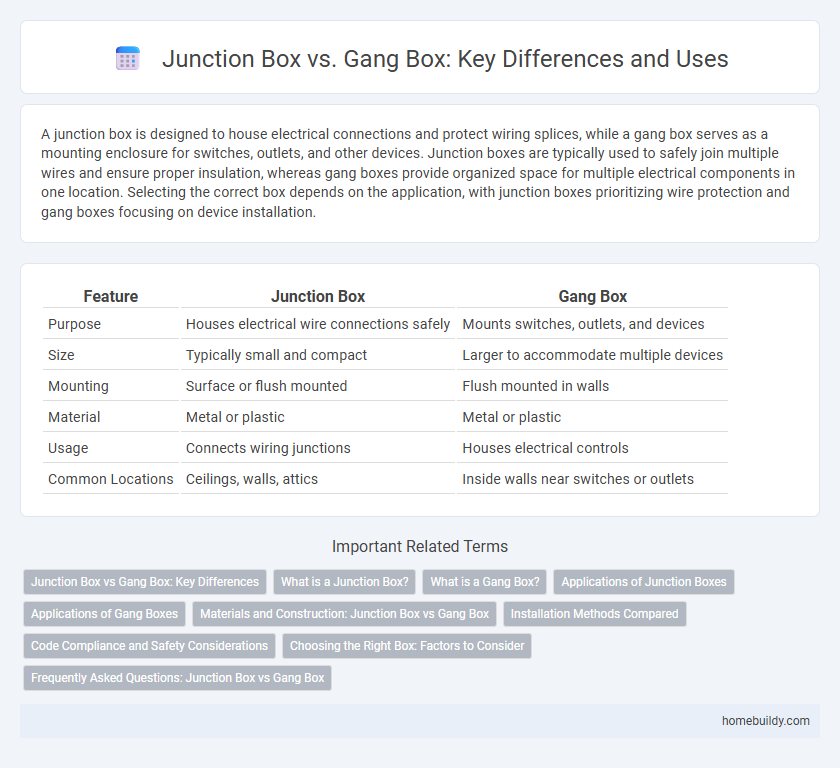A junction box is designed to house electrical connections and protect wiring splices, while a gang box serves as a mounting enclosure for switches, outlets, and other devices. Junction boxes are typically used to safely join multiple wires and ensure proper insulation, whereas gang boxes provide organized space for multiple electrical components in one location. Selecting the correct box depends on the application, with junction boxes prioritizing wire protection and gang boxes focusing on device installation.
Table of Comparison
| Feature | Junction Box | Gang Box |
|---|---|---|
| Purpose | Houses electrical wire connections safely | Mounts switches, outlets, and devices |
| Size | Typically small and compact | Larger to accommodate multiple devices |
| Mounting | Surface or flush mounted | Flush mounted in walls |
| Material | Metal or plastic | Metal or plastic |
| Usage | Connects wiring junctions | Houses electrical controls |
| Common Locations | Ceilings, walls, attics | Inside walls near switches or outlets |
Junction Box vs Gang Box: Key Differences
Junction boxes are designed primarily to protect electrical connections and house wiring splices safely, while gang boxes refer to multi-gang enclosures that accommodate multiple switches or outlets in one unit. Junction boxes typically offer more enclosed space for wiring organization and are often square or rectangular, whereas gang boxes emphasize modularity and are sized to fit specific combinations of devices. Understanding these key differences helps ensure proper electrical installation and code compliance in residential or commercial settings.
What is a Junction Box?
A junction box is an electrical enclosure that houses wire connections and protects them from environmental damage while providing a safe access point for maintenance and inspection. Unlike a gang box, which is designed primarily to hold switches or outlets, a junction box specifically manages wire splices and branching circuits. Constructed from metals or durable plastics, junction boxes ensure compliance with electrical codes and enhance overall wiring system safety.
What is a Gang Box?
A gang box is a type of electrical enclosure designed to house multiple switches, outlets, or wiring connections in a single location, typically mounted within walls. Unlike a junction box, which primarily serves to protect and conceal wire splices, a gang box provides organized access points for multiple electrical devices, accommodating various configurations such as single, double, or triple gangs. Gang boxes are essential in residential and commercial wiring for grouping control devices while ensuring safe and code-compliant electrical installations.
Applications of Junction Boxes
Junction boxes serve as protective enclosures for electrical connections, ensuring safety and preventing short circuits in residential, commercial, and industrial wiring systems. They facilitate the branching and distribution of electrical circuits, making them essential in complex wiring layouts such as lighting installations and power outlets. Unlike gang boxes, which primarily house switches and receptacles, junction boxes are specifically designed to organize and secure wire splices and terminations within electrical networks.
Applications of Gang Boxes
Gang boxes are primarily used for organizing and securing multiple electrical connections in residential and commercial wiring projects. They accommodate several switches or outlets in a single enclosure, facilitating streamlined installation and maintenance. Common applications include wallplates for lighting controls, multiple receptacle outlets, and integrated smart home device panels.
Materials and Construction: Junction Box vs Gang Box
Junction boxes are typically constructed from durable materials such as steel, aluminum, or high-grade plastic, designed to provide robust protection against electrical faults and environmental factors. Gang boxes, often made from similar materials like metal or PVC, are structured with multiple compartments to house several switches or outlets in a single enclosure. The key difference lies in their construction: junction boxes emphasize enclosure integrity for wire splices, while gang boxes prioritize modular space for multiple electrical devices.
Installation Methods Compared
Junction boxes are typically installed using single or multiple conduit entries for electrical wiring, providing a sealed enclosure to protect connections and ensure safety compliance. Gang boxes differ by accommodating multiple switches or outlets in one housing, often mounted within walls using bracket systems or clamps to secure the box flush with the wall surface. Installation of junction boxes prioritizes ease of access to wire splices, while gang boxes focus on neat alignment and integration with wall coverings for switch or outlet assembly.
Code Compliance and Safety Considerations
Junction boxes and gang boxes differ significantly in code compliance and safety considerations, as junction boxes are specifically designed to house electrical wire connections safely, meeting NEC requirements for protecting conductors from physical damage and ensuring proper accessibility. Gang boxes primarily serve as mounting points for multiple devices, such as switches or outlets, and must also comply with NEC standards for spacing and wall support to prevent overcrowding and overheating risks. Proper selection and installation of the correct box type are critical to maintaining electrical system safety, preventing fire hazards, and passing electrical inspections.
Choosing the Right Box: Factors to Consider
Selecting the right box between a junction box and a gang box depends on the intended application, space requirements, and wiring complexity. Junction boxes primarily protect wire connections and accommodate multiple cable entries, offering increased protection for electrical splices. Gang boxes, designed to house switches or outlets, provide modular space for multiple devices and are ideal for organized installations in residential or commercial settings.
Frequently Asked Questions: Junction Box vs Gang Box
A junction box is an enclosure used to protect and organize electrical connections, while a gang box refers to a multi-gang electrical box designed to hold multiple switches or outlets side by side. Common questions about junction box vs gang box often involve their installation purposes, with junction boxes serving as connection points for wiring splices and gang boxes providing structural housing for devices. Understanding the differences in size, capacity, and application helps electricians choose the right box for residential or commercial electrical projects.
Junction box vs Gang box Infographic

 homebuildy.com
homebuildy.com